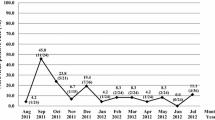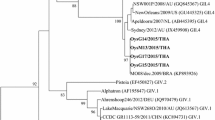Abstract
Detection of noroviruses in bivalve shellfish is difficult because of the low concentration of norovirus and the presence of reverse transcription (RT)-PCR inhibitors. This study aimed to assess the presence of noroviruses in oysters extracted using a proteinase K extraction (ISO 15216 method) and an adsorption–elution method. Seventy oyster samples were extracted using the two extraction methods and evaluated using RT-nested PCR. The results showed norovirus detection rates at an equal frequency of 28.6%, of which a total of 48 (68.6%) samples had corresponding positive or negative results, while there were 22 (31.4%) samples with discrepant results. Norovirus genogroup (G)I, GII, and mixed GI and GII were detected in 20%, 4.3%, and 4.3% of samples, respectively, by the proteinase K extraction method, which comprised of GI.2, GI.5b, GI.6b, GII.4, and GII.17 genotypes. With the adsorption–elution method noroviruses were detected in 17.1%, 8.6%, and 2.9% of samples, respectively, which comprised of GI.2, GII.2, GII.4, and GII.17 genotypes. All norovirus-positive oyster samples were further estimated for genome copy number using RT-quantitative PCR. The oyster samples processed using the adsorption–elution method contained norovirus GI of 3.36 × 101–1.06 × 105 RNA copies/g of digestive tissues and GII of 1.29 × 103–1.62 × 104 RNA copies/g. Only GII (2.20 × 101 and 7.83 × 101 RNA copies/g) could be quantified in samples prepared using the proteinase K extraction method. The results demonstrate the different performance of the two sample-processing methods, and suggest the use of either extraction method in combination with RT-nested PCR for molecular surveillance of norovirus genotypes in oysters.

Similar content being viewed by others
References
Andrade, J. S. R., Fumian, T. M., Leite, J. P. G., Assis, M. R., Bello, G., Mir, D., et al. (2017). Detection and molecular characterization of emergent GII.P17/GII.17 Norovirus in Brazil, 2015. Infection, Genetics and Evolution,51, 28–32.
Anonymous. (2013). Microbiology of food and animal feed—Horizontal method for determination of hepatitis A virus and norovirus in food using real-time RT-PCR—Part 1: Method for quantification. ISO/TS 15216-1:2013 (Withdrawn). Geneva: International Organization for Standardization.
Anonymous. (2017). Microbiology of the food chain—Horizontal method for determination of hepatitis A virus and norovirus using real-time RT-PCR—Part 1: Method for quantification. ISO 15216-1:2017. Geneva: International Organization for Standardization.
Atmar, R. L., Ramani, S., & Estes, M. K. (2018). Human noroviruses: Recent advances in a 50-year history. Current Opinion in Infectious Diseases,31(5), 422–432.
Bartsch, C., Szabo, K., Dinh-Thanh, M., Schrader, C., Trojnar, E., & Johne, R. (2016). Comparison and optimization of detection methods for noroviruses in frozen strawberries containing different amounts of RT-PCR inhibitors. Food Microbiology,60, 124–130.
Chan, M. C. W., Hu, Y., Chen, H., Podkolzin, A. T., Zaytseva, E. V., Komano, J., et al. (2017). Global spread of norovirus GII.17 Kawasaki 308, 2014–2016. Emerging Infectious Diseases,23(8), 1354–1359.
Cheng, D., Zou, S., Liao, N., Shi, X., Chen, J., Zhang, Y., et al. (2018). Evaluation of an extraction method for the detection of GI and GII noroviruses in fruit and vegetable salads. Journal of Food Science,83(2), 393–400.
Cho, H. G., Lee, S. G., Lee, M. Y., Hur, E. S., Lee, J. S., Park, P. H., et al. (2016). An outbreak of norovirus infection associated with fermented oyster consumption in South Korea, 2013. Epidemiology and Infection,144(13), 2759–2764.
Cohen, J. (1960). A coefficient of agreement for nominal scales. Educational and Psychological Measurement,20(1), 37–46.
da Silva Luz, I., & Miagostovich, M. P. (2018). Comparison of viral elution-concentration methods for recovering noroviruses from deli meats. Journal of Virological Methods,260, 49–55.
de Graaf, M., van Beek, J., Vennema, H., Podkolzin, A. T., Hewitt, J., Bucardo, F., et al. (2015). Emergence of a novel GII.17 norovirus—End of the GII.4 era? Euro Surveillance,20(26), 21178.
Farkas, K., Cooper, D. M., McDonald, J. E., Malham, S. K., de Rougemont, A., & Jones, D. L. (2018). Seasonal and spatial dynamics of enteric viruses in wastewater and in riverine and estuarine receiving waters. The Science of The Total Environment,634, 1174–1183.
Farkas, K., Peters, D. E., McDonald, J. E., de Rougemont, A., Malham, S. K., & Jones, D. L. (2017). Evaluation of two triplex one-step qRT-PCR assays for the quantification of human enteric viruses in environmental samples. Food and Environmental Virology,9(3), 342–349.
Fitzgerald, T. L., Merritt, T. D., Zammit, A., McLeod, C., Landinez, L. M., White, P. A., et al. (2014). An outbreak of norovirus genogroup II associated with New South Wales oysters. Communicable Diseases Intelligence Quarterly Report,38(1), E9–E15.
Fuentes, C., Guix, S., Pérez-Rodriguez, F. J., Fuster, N., Carol, M., Pintó, R. M., et al. (2014). Standardized multiplex one-step qRT-PCR for hepatitis A virus, norovirus GI and GII quantification in bivalve mollusks and water. Food Microbiology,40, 55–63.
Hardstaff, J. L., Clough, H. E., Lutje, V., McIntyre, K. M., Harris, J. P., Garner, P., et al. (2018). Foodborne and food-handler norovirus outbreaks: A systematic review. Foodborne Pathogens and Disease,15(10), 589–597.
Hennechart-Collette, C., Martin-Latil, S., Fraisse, A., & Perelle, S. (2017). Comparison of three extraction methods to detect noroviruses in dairy products. Food Microbiology,61, 113–119.
Imamura, S., Kanezashi, H., Goshima, T., Suto, A., Ueki, Y., Sugawara, N., et al. (2018). Effect of high pressure processing on a wide variety of human noroviruses naturally present in aqua-cultured Japanese oysters. Foodborne Pathogens and Disease,15(10), 621–626.
Iritani, N., Kaida, A., Abe, N., Kubo, H., Sekiguchi, J., Yamamoto, S. P., et al. (2014). Detection and genetic characterization of human enteric viruses in oyster-associated gastroenteritis outbreaks between 2001 and 2012 in Osaka City, Japan. Journal of Medical Virology,86(12), 2019–2025.
Jothikumar, N., Lowther, J. A., Henshilwood, K., Lees, D. N., Hill, V. R., & Vinje, J. (2005). Rapid and sensitive detection of noroviruses by using TaqMan-based one-step reverse transcription-PCR assays and application to naturally contaminated shellfish samples. Applied and Environmental Microbiology,71(4), 1870–1875.
Kageyama, T., Kojima, S., Shinohara, M., Uchida, K., Fukushi, S., Hoshino, F. B., et al. (2003). Broadly reactive and highly sensitive assay for Norwalk-like viruses based on real-time quantitative reverse transcription-PCR. Journal of Clinical Microbiology,41(4), 1548–1557.
Kittigul, L., Rupprom, K., Che-Arsae, M., Pombubpa, K., Thongprachum, A., Hayakawa, S., et al. (2019). Occurrence of noroviruses in recycled water and sewage sludge: Emergence of recombinant norovirus strains. Journal of Applied Microbiology,126(4), 1290–1301.
Kittigul, L., Thamjaroen, A., Chiawchan, S., Chavalitshewinkoon-Petmitr, P., Pombubpa, K., & Diraphat, P. (2016). Prevalence and molecular genotyping of noroviruses in market oysters, mussels, and cockles in Bangkok, Thailand. Food and Environmental Virology,8(2), 133–140.
Kojima, S., Kageyama, T., Fukushi, S., Hoshino, F. B., Shinohara, M., Uchida, K., et al. (2002). Genogroup-specific PCR primers for detection of Norwalk-like viruses. Journal of Virological Methods,100(1–2), 107–114.
La Rosa, G., Della Libera, S., Iaconelli, M., Proroga, Y. T. R., De Medici, D., Martella, V., et al. (2017). Detection of norovirus GII.17 Kawasaki 2014 in shellfish, marine water and underwater sewage discharges in Italy. Food and Environmental Virology,9(3), 326–333.
Langlet, J., Kaas, L., Croucher, D., & Hewitt, J. (2018). Effect of the shellfish proteinase K digestion method on norovirus capsid Integrity. Food and Environmental Virology,10(2), 151–158.
Le Guyader, F. S., Atmar, R. L., & Le Pendu, J. (2012). Transmission of viruses through shellfish: When specific ligands come into play. Current Opinion in Virology,2(1), 103–110.
Le Guyader, F. S., Parnaudeau, S., Schaeffer, J., Bosch, A., Loisy, F., Pommepuy, M., et al. (2009). Detection and quantification of noroviruses in shellfish. Applied and Environmental Microbiology,75(3), 618–624.
Le Mennec, C., Parnaudeau, S., Rumebe, M., Le Saux, J. C., Piquet, J. C., & Le Guyader, S. F. (2017). Follow-up of norovirus contamination in an oyster production area linked to repeated outbreaks. Food and Environmental Virology,9(1), 54–61.
Liu, L. T., Kuo, T. Y., Wu, C. Y., Liao, W. T., Hall, A. J., & Wu, F. T. (2017). Recombinant GII.P16-GII.2 norovirus, Taiwan, 2016. Emerging Infectious Diseases,23(7), 1180–1183.
Loury, P., Le Guyader, F. S., Le Saux, J. C., Ambert-Balay, K., Parrot, P., & Hubert, B. (2015). A norovirus oyster-related outbreak in a nursing home in France, January 2012. Epidemiology and Infection,143(12), 2486–2493.
Lowmoung, T., Pombubpa, K., Duangdee, T., Tipayamongkholgul, M., & Kittigul, L. (2017). Distribution of naturally occurring norovirus genogroups I, II, and IV in oyster tissues. Food and Environmental Virology,9(4), 415–422.
Lowther, J. A., Gustar, N. E., Powell, A. L., Hartnell, R. E., & Lees, D. N. (2012). Two-year systematic study to assess norovirus contamination in oysters from commercial harvesting areas in the United Kingdom. Applied and Environmental Microbiology,78(16), 5812–5817.
Lowther, J. A., Gustar, N. E., Powell, A. L., O’Brien, S., & Lees, D. N. (2018). A one-year survey of norovirus in UK oysters collected at the point of sale. Food and Environmental Virology,10(3), 278–287.
Nguyen, G. T., Pu, J., Miura, T., Ito, H., Kazama, S., Konta, Y., et al. (2018). Oyster contamination with human noroviruses impacted by urban drainage and seasonal flooding in Vietnam. Food and Environmental Virology,10(1), 61–71.
Purpari, G., Macaluso, G., DI Bella, S., Gucciardi, F., Mira, F., DI Marco, P., et al. (2019). Molecular characterization of human enteric viruses in food, water samples and surface swabs in Sicily. International Journal of Infectious Diseases,80, 66–72.
Quang Le, H., Suffredini, E., Tien Pham, D., Kim To, A., & De Medici, D. (2018). Development of a method for direct extraction of viral RNA from bivalve molluscs. Letters in Applied Microbiology,67(5), 426–434.
Rupprom, R., Chavalitshewinkoon-Petmitr, P., Diraphat, P., Vinjé, J., & Kittigul, L. (2018). Development of a one step TaqMan quantitative RT-PCR for detection of norovirus genogroups I and II in oyster. The Southeast Asian Journal of Tropical Medicine and Public Health,49(6), 1017–1028.
Summa, M., & Maunula, L. (2018). Rapid detection of human norovirus in frozen raspberries. Food and Environmental Virology,10(1), 51–60.
Tamura, K., Stecher, G., Peterson, D., Filipski, A., & Kumar, S. (2013). MEGA6: Molecular evolutionary genetics analysis version 6.0. Molecular Biology and Evolution,30(12), 2725–2729.
Tohma, K., Lepore, C. J., Ford-Siltz, L. A., & Parra, G. I. (2017). Phylogenetic analyses suggest that factors other than the capsid protein play a role in the epidemic potential of GII.2 norovirus. Sphere,2(3), e00187-17.
Vinjé, J. (2015). Advances in laboratory methods for detection and typing of norovirus. Journal of Clinical Microbiology,53(2), 373–381.
Woods, J. W., Calci, K. R., Marchant-Tambone, J. G., & Burkhardt, W., 3rd. (2016). Detection and molecular characterization of norovirus from oysters implicated in outbreaks in the US. Food Microbiology,59, 76–84.
Yu, Y., Cai, H., Hu, L., Lei, R., Pan, Y., Yan, S., et al. (2015). Molecular epidemiology of oyster-related human noroviruses and their global genetic diversity and temporal-geographical distribution from 1983 to 2014. Applied and Environmental Microbiology,81(21), 7615–7624.
Acknowledgements
This work was supported by a research grant from the Thai Government Budget through Mahidol University, Bangkok, Thailand, fiscal years 2015–2017. The proof reading of this manuscript was supported by the Editorial Office, Faculty of Graduate Studies, Mahidol University.
Author information
Authors and Affiliations
Corresponding author
Additional information
Publisher's Note
Springer Nature remains neutral with regard to jurisdictional claims in published maps and institutional affiliations.
Rights and permissions
About this article
Cite this article
Tunyakittaveeward, T., Rupprom, K., Pombubpa, K. et al. Norovirus Monitoring in Oysters Using Two Different Extraction Methods. Food Environ Virol 11, 374–382 (2019). https://doi.org/10.1007/s12560-019-09396-y
Received:
Accepted:
Published:
Issue Date:
DOI: https://doi.org/10.1007/s12560-019-09396-y




